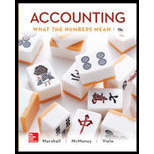
Concept Introduction:
Time value of money: Time value of money is the concept that differentiates the value of money received today and the value of same money received in future. According to this concept, the same amount of money to be received in future shall have lower present value (value of the money today) due to the interest that could be earned on that money.
NPV:
IRR:
Requirement-a:
To Calculate:
The NPV of the project
Concept Introduction:
Time value of money: Time value of money is the concept that differentiates the value of money received today and the value of same money received in future. According to this concept, the same amount of money to be received in future shall have lower present value (value of the money today) due to the interest that could be earned on that money.
NPV: Net present value (NPV) is the method to evaluate the project feasibility. This method calculates the present value of cash inflows and outflows, and then calculates the net present value of the investment. A project should be accepted if it has a positive NPV. The formula to calculate the NPV is as follows:
IRR: Internal
Requirement-b:
To Calculate:
The IRR of the project
Want to see the full answer?
Check out a sample textbook solution
Chapter 16 Solutions
Accounting: What the Numbers Mean
- During the month of May, Nakamura Manufacturing used $45,300 of direct materials and incurred $53,700 of direct labor costs. Nakamura applied overhead to products in the amount of $32,400. If the cost of goods manufactured was $169,000 and the ending work in process balance was $31,200, the beginning work in process must have been equal to _. Helparrow_forwardWhat is plantwide overhead rate?arrow_forwardCan you help me solve this financial accounting problem with the correct methodology?arrow_forward
- Can you help me solve this general accounting question using the correct accounting procedures?arrow_forwardPlease explain the correct approach for solving this general accounting question.arrow_forwardI am trying to find the accurate solution to this financial accounting problem with the correct explanation.arrow_forward
- I need help finding the accurate solution to this general accounting problem with valid methods.arrow_forwardHi expert please given correct answer with accounting questionarrow_forwardThe Evangeline Company makes two products, X and Y, from a common input, Z. In March, Evangeline used 30,000 pounds of Z to make 20,000 pounds of X and 10,000 pounds of Y. The cost of Z was $1.00 per pound and X and Y can be sold for $7.50 and $10.00, respectively; Evangeline incurred additional processing costs of $30,000 to further process X and $20,000 to further process Y. Using the net realizable value method, how much of the cost of Z should be allocated to X? Multiple Choice $22,000 None of the choices is correct. $20,000 $18,000 $16,000arrow_forward

 AccountingAccountingISBN:9781337272094Author:WARREN, Carl S., Reeve, James M., Duchac, Jonathan E.Publisher:Cengage Learning,
AccountingAccountingISBN:9781337272094Author:WARREN, Carl S., Reeve, James M., Duchac, Jonathan E.Publisher:Cengage Learning, Accounting Information SystemsAccountingISBN:9781337619202Author:Hall, James A.Publisher:Cengage Learning,
Accounting Information SystemsAccountingISBN:9781337619202Author:Hall, James A.Publisher:Cengage Learning, Horngren's Cost Accounting: A Managerial Emphasis...AccountingISBN:9780134475585Author:Srikant M. Datar, Madhav V. RajanPublisher:PEARSON
Horngren's Cost Accounting: A Managerial Emphasis...AccountingISBN:9780134475585Author:Srikant M. Datar, Madhav V. RajanPublisher:PEARSON Intermediate AccountingAccountingISBN:9781259722660Author:J. David Spiceland, Mark W. Nelson, Wayne M ThomasPublisher:McGraw-Hill Education
Intermediate AccountingAccountingISBN:9781259722660Author:J. David Spiceland, Mark W. Nelson, Wayne M ThomasPublisher:McGraw-Hill Education Financial and Managerial AccountingAccountingISBN:9781259726705Author:John J Wild, Ken W. Shaw, Barbara Chiappetta Fundamental Accounting PrinciplesPublisher:McGraw-Hill Education
Financial and Managerial AccountingAccountingISBN:9781259726705Author:John J Wild, Ken W. Shaw, Barbara Chiappetta Fundamental Accounting PrinciplesPublisher:McGraw-Hill Education





